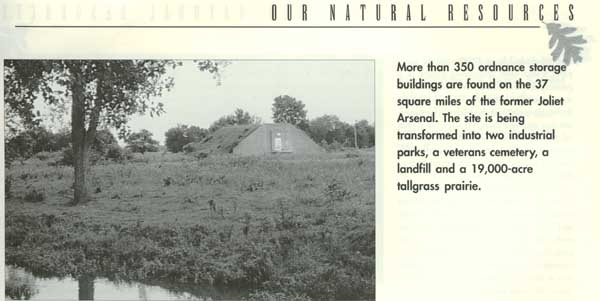

|
world War II it produced 5.5 million tons of TNT per week, with production ceasing shortly after the Vietnam War. For safety and security reasons, the arsenal was a big place-23,500 acres, which equals almost 37 square miles. It contained 200 miles of roads, 166 miles of railroad, 1,462 buildings, including 392 ammunition storage bunkers, 6,000 acres of pasture, 10,700 acres of row crops, 37 miles of chain-link fence and three significant Indian burial grounds. The buildings where ammunition was manufactured and stored were surrounded by hundreds of acres of fenced-in buffer lands. Ac-cording to Fran Harty DNR Division of Natural Heritage Region II administrator, the barrel-shaped concrete ammunition storage bunkers are five feet thick on the sides, but thinner on the top and bottom. "That way, if one blew up the blast would go up and down rather than out where it could cause a chain reaction," he said. "One did blow up at the Savanna Army Depot and left a huge hole in the ground." The Army decommissioned the arsenal in 1992. Under the leadership of former Congressman George Sangmeister, a 24-member Joliet Arsenal Citizen Planning Commssion was formed to determine the best uses for the land. Commission members represented state and local governments, as well as various environ-mental and conservation organizations. On May 30, 1995, the commission unanimously approved a concept map that called for the arsenal to be divided as follows: two industrial parks totaling 3,000 acres; a 982-acre national veterans cemetery; a 455-acre landfill; and a 19,023-acre tallgrass prairie. With the bipartisan support of Gov. Jim Edgar, Sen. Carol Moseley-Braun, former Sen. Paul Simon and Congressman Jerty Weller, the plan received official confirmation when Congress passed the Illinois Land Conservation Act of 1995. The act called for the industrial areas to be turned over to the state-chartered Joliet Arsenal Development Authority; the cemetery to the U.S. Department of Veterans Affairs; the landfill to Will County; and the prairie to the U.S. Forest Service. The act also called for the Midewin (pronounced Mid-DAY-win, it is a Pottowatomi Indian term meaning "healing society") National Tallgrass Prairie to be jointly managed by the Forest Service and the state of Illinois. |
"What's important about this legislation, other than the fact that it's the first national tallgrass prairie, is that it actually sets purposes for Midewin," said Harty DNR's point man for Midewin. "It's unusual for Congress to actually legislate the purposes. It makes planning a little bit easier since you already have your guidelines." The four purposes spelled out in the legislation are: to manage the land and water resources in a manner that will conserve and enhance the native populations and habitats of fish, wildlife and plants; to provide opportunities for scientific, environmental and land use education and research; to allow the continuation of agricultural uses for 20 years; and to provide a variety of recreational opportunities that are not inconsistent with the first three purposes. Located in the heart of the Prairie Parklands Macrosite, Midewin consists of prairie groves, dolomite prairies, wetlands and seeps, upland forests and three streams. It is home to 18 statelisted endangered and threatened species, 108 species of birds, including 25 that are area-sensitive, 40 species of fish, 23 species of amphibians and reptiles, 348 native plant species, 27 species of mammals, nine species of mussels and numerous insect species. The Illinois Natural History Survey has two full-time staff members on site, Dr. Chris Whelan, a bird ecologist, and Dr. Brenda Molano-Flores, a botanist, who are involved in significant monitoring activities. Their research should provide answers to the kinds of technical questions necessary for successful restoration and also ensure that science will be integrated into management decisions. Hardy said Midewin's diversity and vast size offer unparalleled opportunities for species management. "This area has the largest concentration of grassland birds in the state, particularly for upland sandpipers and some other area-sensitive species like grasshopper sparrows |